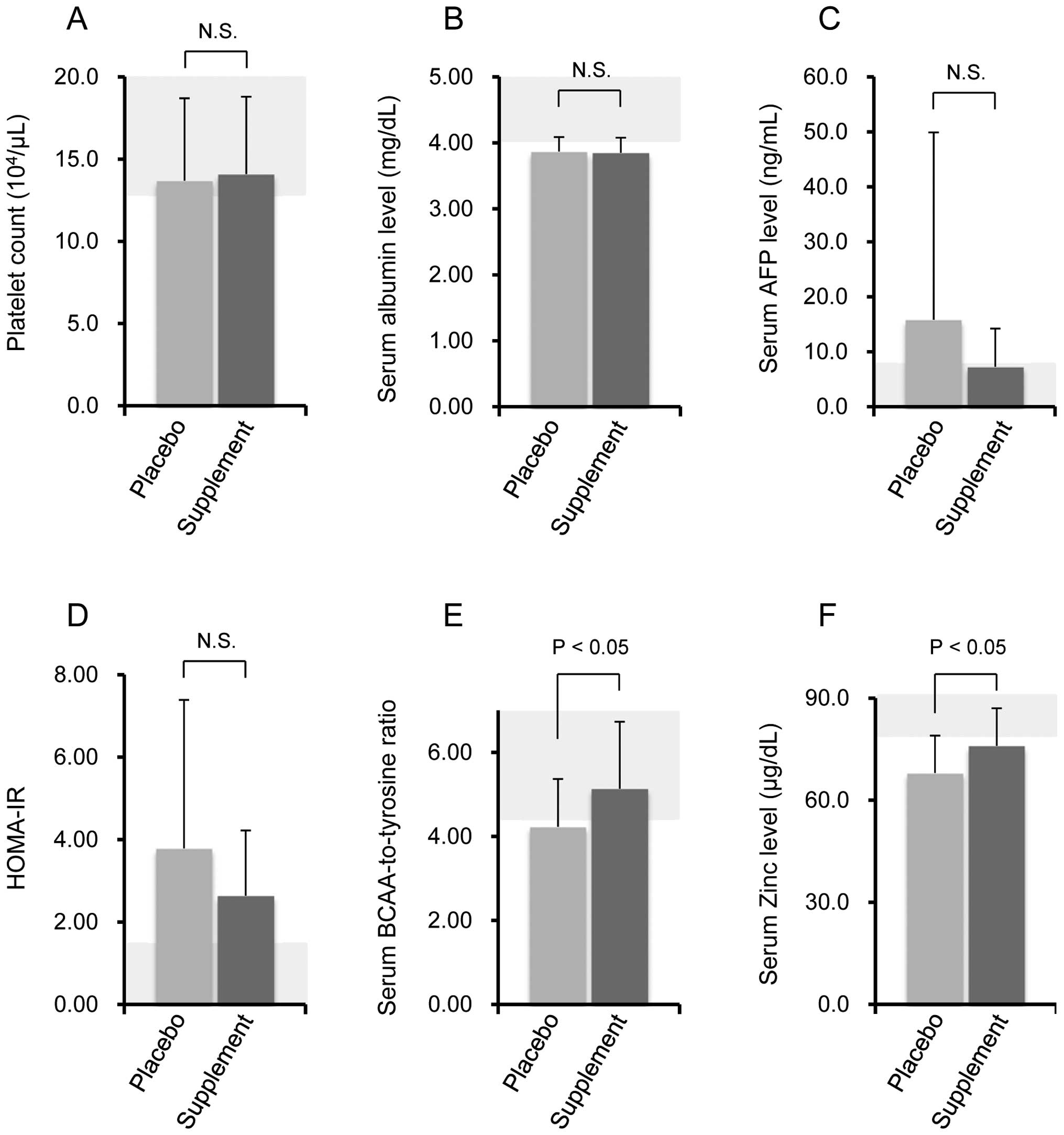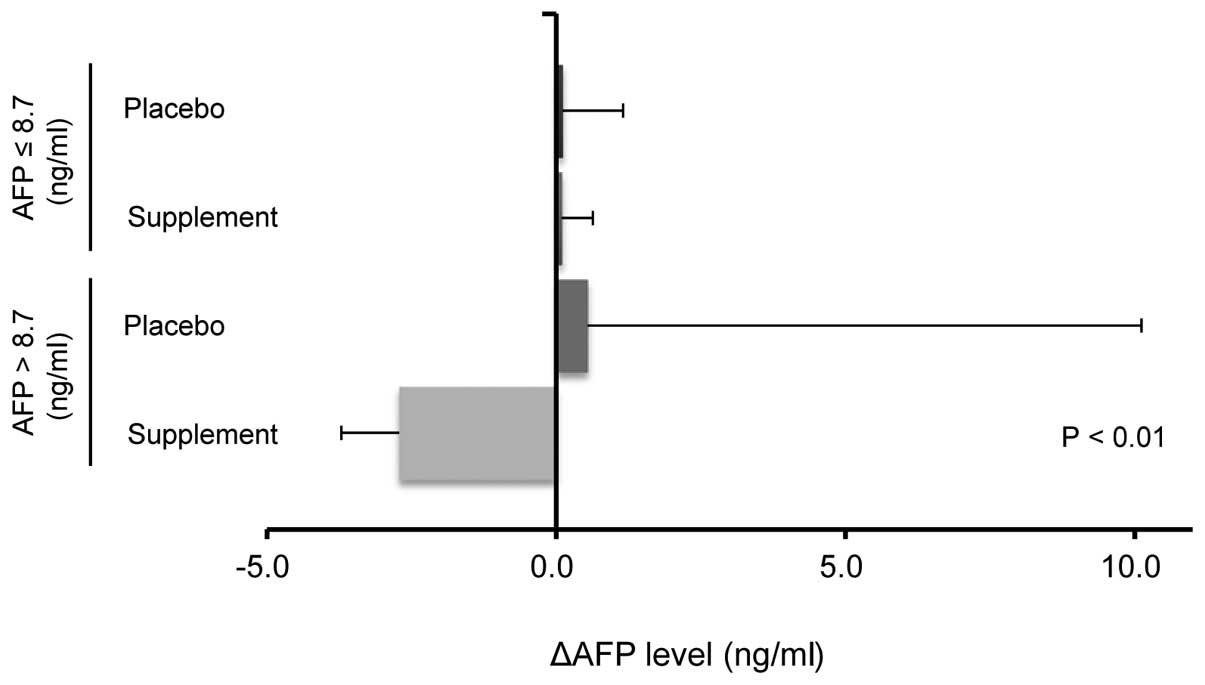|
1
|
Kawaguchi T, Izumi N, Charlton MR and Sata
M: Branched-chain amino acids as pharmacological nutrients in
chronic liver disease. Hepatology. 54:1063–1070. 2011. View Article : Google Scholar : PubMed/NCBI
|
|
2
|
Kawaguchi T, Taniguchi E and Sata M:
Effects of oral branched-chain amino acids on hepatic
encephalopathy and outcome in patients with liver cirrhosis. Nutr
Clin Pract. 28:580–588. 2013. View Article : Google Scholar : PubMed/NCBI
|
|
3
|
Ishikawa T, Kubota T, Horigome R, Kimura
N, Honda H, Iwanaga A, et al: Branched-chain amino acids to
tyrosine ratio (BTR) predicts intrahepatic distant recurrence and
survival for early hepatocellular carcinoma.
Hepatogastroenterology. 60:2013.PubMed/NCBI
|
|
4
|
Kawaguchi T, Shiraishi K, Ito T, Suzuki K,
Koreeda C, Ohtake T, et al: Branched-chain amino acids prevent
hepatocarcinogenesis and prolong survival of patients with
cirrhosis. Clin Gastroenterol Hepatol. in press. 2014. View Article : Google Scholar
|
|
5
|
Auld DS, Kawaguchi H, Livingston DM and
Vallee BL: RNA-dependent DNA polymerase (reverse transcriptase)
from avian myeloblastosis virus: a zinc metalloenzyme. Proc Natl
Acad Sci USA. 71:2091–2095. 1974. View Article : Google Scholar : PubMed/NCBI
|
|
6
|
Kumar R, Manning J, Spendlove HE,
Kremmidiotis G, McKirdy R, Lee J, et al: ZNF652, a novel zinc
finger protein, interacts with the putative breast tumor suppressor
CBFA2T3 to repress transcription. Mol Cancer Res. 4:655–665. 2006.
View Article : Google Scholar : PubMed/NCBI
|
|
7
|
Moriyama M, Matsumura H, Fukushima A,
Ohkido K, Arakawa Y, Nirei K, et al: Clinical significance of
evaluation of serum zinc concentrations in C-viral chronic liver
disease. Dig Dis Sci. 51:1967–1977. 2006. View Article : Google Scholar : PubMed/NCBI
|
|
8
|
Katayama K, Sakakibara M, Imanaka K,
Ohkawa K, Matsunaga T, Naito M, et al: Effect of zinc
supplementation in patients with type C liver cirrhosis. O J Gas.
1:22–28. 2011.
|
|
9
|
Matsumura H, Nirei K, Nakamura H, Arakawa
Y, Higuchi T, Hayashi J, et al: Zinc supplementation therapy
improves the outcome of patients with chronic hepatitis C. J Clin
Biochem Nutr. 51:178–184. 2012.PubMed/NCBI
|
|
10
|
Muto Y, Sato S, Watanabe A, Moriwaki H,
Suzuki K, Kato A, et al: Effects of oral branched-chain amino acid
granules on event-free survival in patients with liver cirrhosis.
Clin Gastroenterol Hepatol. 3:705–713. 2005. View Article : Google Scholar : PubMed/NCBI
|
|
11
|
Muto Y, Sato S, Watanabe A, Moriwaki H,
Suzuki K, Kato A, et al: Overweight and obesity increase the risk
for liver cancer in patients with liver cirrhosis and long-term
oral supplementation with branched-chain amino acid granules
inhibits liver carcinogenesis in heavier patients with liver
cirrhosis. Hepatol Res. 35:204–214. 2006.PubMed/NCBI
|
|
12
|
Kawaguchi T, Nagao Y, Matsuoka H, Ide T
and Sata M: Branched-chain amino acid-enriched supplementation
improves insulin resistance in patients with chronic liver disease.
Int J Mol Med. 22:105–112. 2008.PubMed/NCBI
|
|
13
|
Kawaguchi T, Taniguchi E, Itou M, Sumie S,
Oriishi T, Matsuoka H, et al: Branched-chain amino acids improve
insulin resistance in patients with hepatitis C virus-related liver
disease: report of two cases. Liver Int. 27:1287–1292.
2007.PubMed/NCBI
|
|
14
|
Nagao Y, Kawaguchi T, Ide T and Sata M:
Effect of branched-chain amino acid-enriched nutritional
supplementation on interferon therapy in Japanese patients with
chronic hepatitis C virus infection: a retrospective study. Virol
J. 9:2822012. View Article : Google Scholar : PubMed/NCBI
|
|
15
|
Nagao Y, Kawaguchi T, Kakuma T, Ide T and
Sata M: Post-marketing surveillance study for efficacy and safety
of Aminofeel®, a branched chain amino acids-enriched
supplement including zinc. J New Rem & Clin. 60:198–215.
2011.(In Japanese).
|
|
16
|
Nagao Y, Matsuoka H, Kawaguchi T and Sata
M: Aminofeel® improves the sensitivity to taste in
patients with HCV-infected liver disease. Med Sci Monit.
16:PI7–P12. 2010.PubMed/NCBI
|
|
17
|
Kawaguchi T, Yoshida T, Harada M, Hisamoto
T, Nagao Y, Ide T, et al: Hepatitis C virus down-regulates insulin
receptor substrates 1 and 2 through up-regulation of suppressor of
cytokine signaling 3. Am J Pathol. 165:1499–1508. 2004. View Article : Google Scholar : PubMed/NCBI
|
|
18
|
Dupont WD and Plummer WD Jr: Power and
sample size calculations. A review and computer program. Control
Clin Trials. 11:116–128. 1990. View Article : Google Scholar : PubMed/NCBI
|
|
19
|
Suzuki K, Koizumi K, Ichimura H, Oka S,
Takada H and Kuwayama H: Measurement of serum branched-chain amino
acids to tyrosine ratio level is useful in a prediction of a change
of serum albumin level in chronic liver disease. Hepatol Res.
38:267–272. 2008. View Article : Google Scholar
|
|
20
|
Riggio O, Merli M, Capocaccia L, Caschera
M, Zullo A, Pinto G, et al: Zinc supplementation reduces blood
ammonia and increases liver ornithine transcarbamylase activity in
experimental cirrhosis. Hepatology. 16:785–789. 1992. View Article : Google Scholar : PubMed/NCBI
|
|
21
|
Chavez-Tapia NC, Cesar-Arce A,
Barrientos-Gutierrez T, Villegas-Lopez FA, Mendez-Sanchez N and
Uribe M: A systematic review and meta-analysis of the use of oral
zinc in the treatment of hepatic encephalopathy. Nutr J. 12:742013.
View Article : Google Scholar : PubMed/NCBI
|
|
22
|
Hagiwara A, Nishiyama M and Ishizaki S:
Branched-chain amino acids prevent insulin-induced hepatic tumor
cell proliferation by inducing apoptosis through mTORC1 and
mTORC2-dependent mechanisms. J Cell Physiol. 227:2097–2105. 2012.
View Article : Google Scholar
|
|
23
|
Nakao K and Ichikawa T: Recent topics on
alpha-fetoprotein. Hepatol Res. 43:820–825. 2013. View Article : Google Scholar : PubMed/NCBI
|
|
24
|
Xie Z, Zhang H, Tsai W, Zhang Y, Du Y,
Zhong J, et al: Zinc finger protein ZBTB20 is a key repressor of
alpha-fetoprotein gene transcription in liver. Proc Natl Acad Sci
USA. 105:10859–10864. 2008. View Article : Google Scholar : PubMed/NCBI
|
|
25
|
Nakanishi C, Doi H, Katsura K and Satomi
S: Treatment with L-valine ameliorates liver fibrosis and restores
thrombopoiesis in rats exposed to carbon tetrachloride. Tohoku J
Exp Med. 221:151–159. 2010. View Article : Google Scholar : PubMed/NCBI
|
|
26
|
Zhang Y, Guo K, LeBlanc RE, Loh D,
Schwartz GJ and Yu YH: Increasing dietary leucine intake reduces
diet-induced obesity and improves glucose and cholesterol
metabolism in mice via multimechanisms. Diabetes. 56:1647–1654.
2007. View Article : Google Scholar : PubMed/NCBI
|
|
27
|
Ikehara O, Kawasaki N, Maezono K, Komatsu
M and Konishi A: Acute and chronic treatment of L-isoleucine
ameliorates glucose metabolism in glucose-intolerant and diabetic
mice. Biol Pharm Bull. 31:469–472. 2008. View Article : Google Scholar : PubMed/NCBI
|
|
28
|
Ishida H, Kato T, Takehana K, Tatsumi T,
Hosui A, Nawa T, et al: Valine, the branched-chain amino acid,
suppresses hepatitis C virus RNA replication but promotes
infectious particle formation. Biochem Biophys Res Commun.
437:127–133. 2013. View Article : Google Scholar : PubMed/NCBI
|
|
29
|
Kugelmas M: Preliminary observation: oral
zinc sulfate replacement is effective in treating muscle cramps in
cirrhotic patients. J Am Coll Nutr. 19:13–15. 2000. View Article : Google Scholar : PubMed/NCBI
|
|
30
|
Sako K, Imamura Y, Nishimata H, Tahara K,
Kubozono O and Tsubouchi H: Branched-chain amino acids supplements
in the late evening decrease the frequency of muscle cramps with
advanced hepatic cirrhosis. Hepatol Res. 26:327–329. 2003.
View Article : Google Scholar : PubMed/NCBI
|














